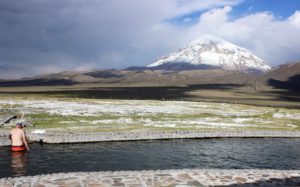Sajama National Park, Bolivia, Apr 8 (EFE).- The Sajama National Park, Bolivia’s oldest protected area, attracts mostly foreign tourists with its wide variety of fauna, thermal pools, geysers and the country’s tallest peak and also provides a successful example of a community-based tourism model.
Designated as a protected area in 1939, this national park is situated at approximately 4,300 meters (14,100 feet) above sea level in the Andean department of Oruro, which borders Chile.
Its 100,000 hectares (386 square miles) are home to wildlife such as the Darwin’s rhea, a flightless bird found in the Andean plateau; foxes; the Andean mountain cat; flamencos; pumas; and Andean hairy armadillos.

Llamas, alpacas and small groups of vicuñas can be easily spotted in the park’s vast semi-arid high plateau, with the imposing presence of the 6,542-meter Nevado Sajama in the background.
The area also is home to five indigenous communities whose main source of income is tourism and who are committed to protecting local flora and fauna.
“The communities here live from community tourism. It’s the main revenue-generating resource for education and health,” the director of this national park, Julio Mamani, told EFE.
Several of the communities have built lodging for tourists, many of whom arrive with plans to scale the summit of the snow-capped peak known locally as “Doctor Sajama.”
Guests at these eco-lodges also get a taste of local culture through a steady stream of performances by area musicians.
“We want the people who visit to come away with the best possible memories of our home, Sajama, and to see that we have a lot to offer,” Martha Guarachi, manager of the lodge in the Tomarapi community, told EFE.
Residents also offer guests a sampling of typical dishes that are based on llama or alpaca meat and also served with potatoes and quinoa.
In late March, chefs from the chic La Paz restaurants Gustu and Jardin de Asia and biologists with the Bolivian chapter of the New York-based Wildlife Conservation Society visited communities in this region to get a first-hand look at the ingredients used in the local cuisine.
“We also hope to bring attention to the beauty of these places and also create tourist opportunities that benefit the communities,” Englishman Robert Wallace, WCS Bolivia’s director of the Greater Madidi-Tambopata Landscape Conservation Program, told EFE.
In addition, these communities offer visits to the Caripe lookout point, where tourists can observe alpacas roaming free in the high Andean wetlands with the majestic Nevado Sajama in the distance.
Another popular attraction is the open-air Manasaya hot springs, which have medicinal properties and, according to local residents, also serve to purify the soul.
“This place is open to the public year-round, with tourists coming from all over the world to bathe in these medicinal, mineral-rich waters. They also take the opportunity to get some beautiful photos with Sajama in the background,” Adrian Cañari, the park’s legal representative, told EFE.
The early-morning hours are the best time to visit the geysers, columns of hot water and steam that erupt to the surface and soar to various heights.
The most adventurous tourists also can hire the mountain guides and teams they need to scale Nevado Sajama, a snow-capped, extinct conical volcano, or other nearby peaks such as Parinacota (6,200 m); Pomarapi (6,000 m), which straddles the Bolivian-Chilean border; and Acotango (6,079 m).
Most visitors arrive from France, Italy, Spain, Germany and various Asian countries, while relatively few tourists hail from other parts of Latin America, Mamani said.
He added that 90 percent of visitors to Sajama National Park are foreigners.
